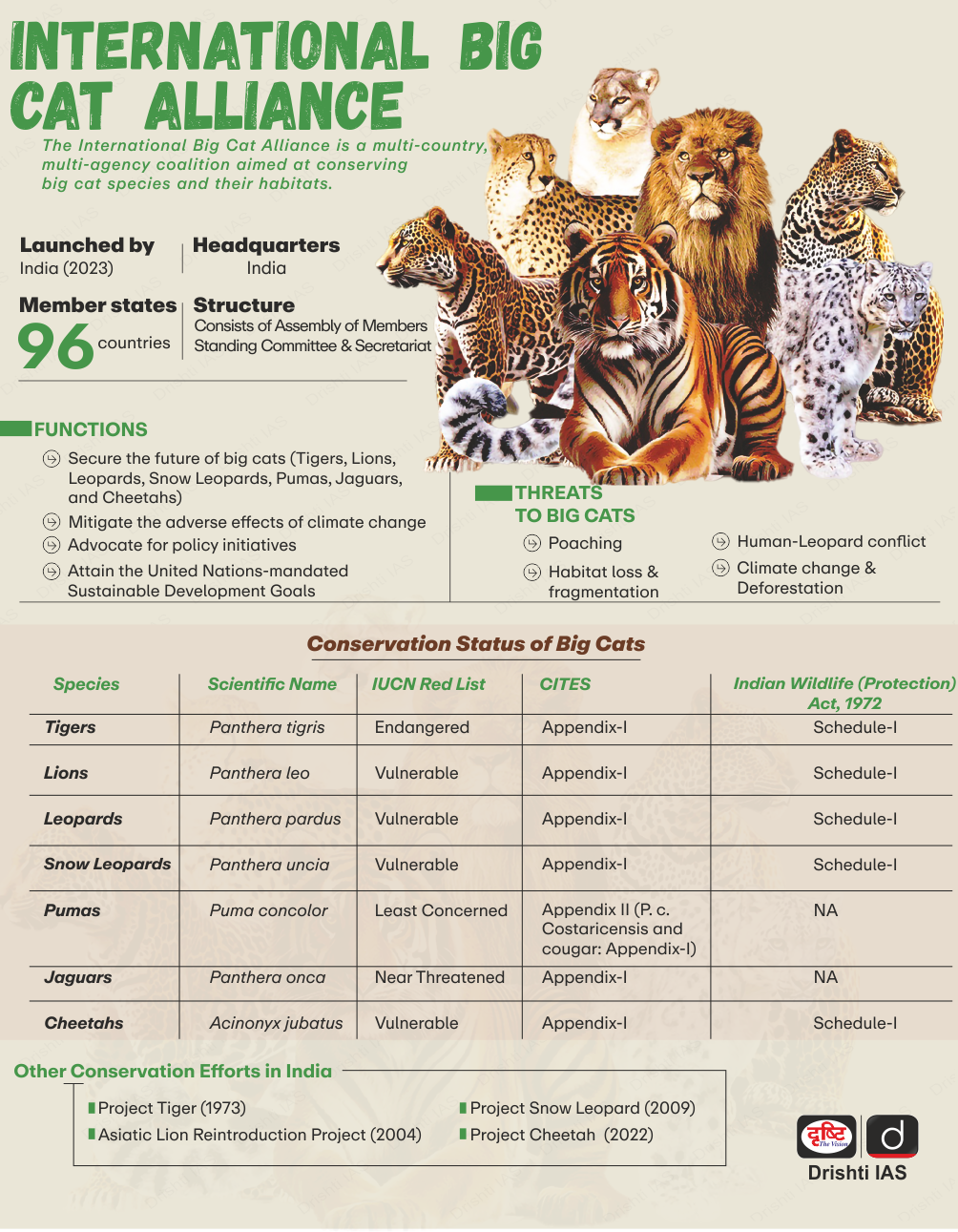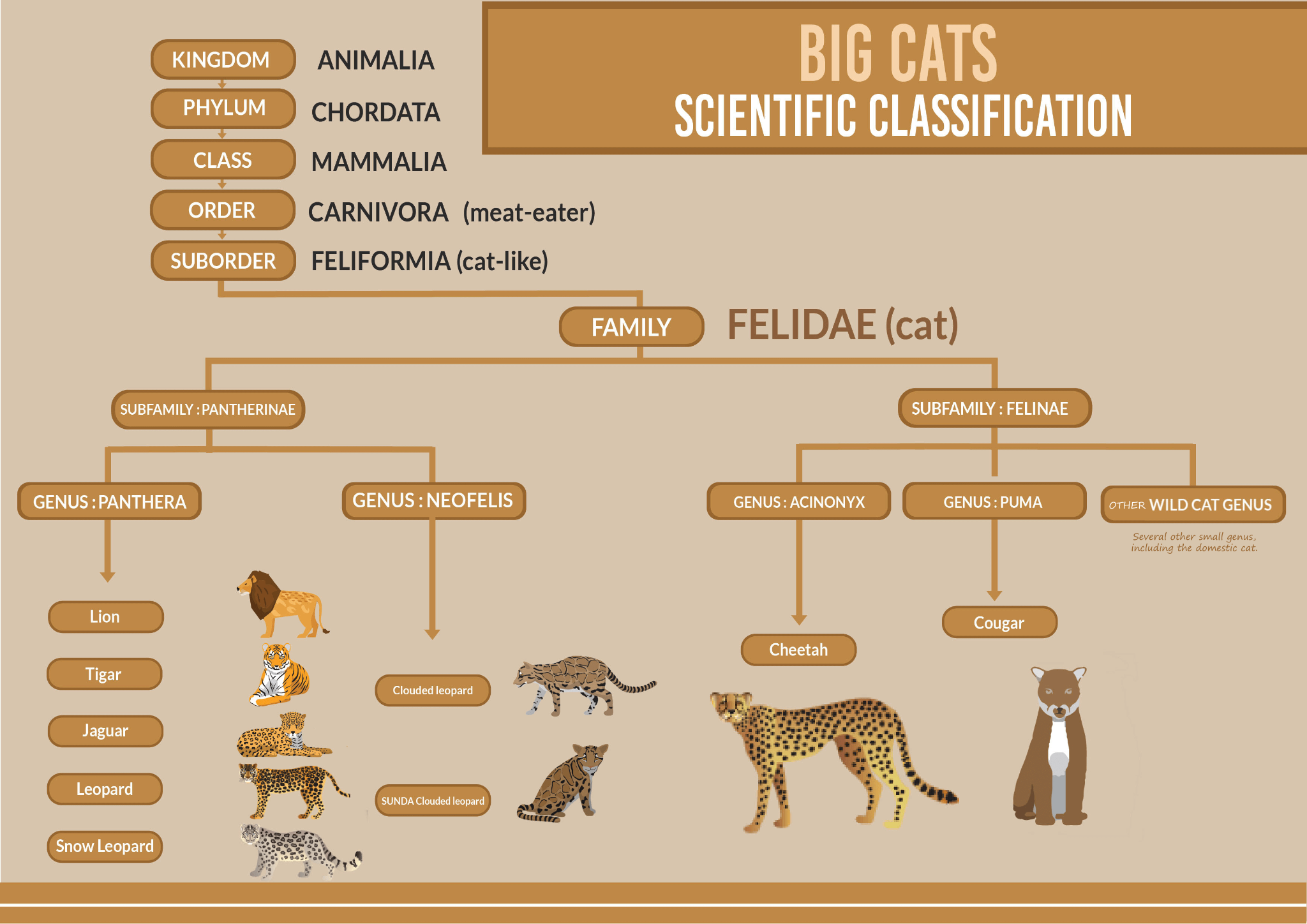Important Facts For Prelims
International Big Cat Alliance
- 24 Sep 2024
- 5 min read
Why in News?
Recently, India has officially joined the International Big Cat Alliance (IBCA), which was launched by the Prime Minister in 2023. IBCA aims to protect big cats and their habitats.
Note:
- Though India launched the International Big Cat Alliance (IBCA) as a global institution, it must still sign and ratify its Framework Agreement, similar to its approach with other international agreements and institutions, such as the Paris Agreement, the Convention on Biological Diversity (CBD), and the Shanghai Cooperation Organization (SCO).
What is the International Big Cat Alliance (IBCA)?
- About:
- The International Big Cat Alliance (IBCA) is a multi-country, multi-agency coalition of 96 big cat range countries, and non-range countries aimed at conserving 7 big cats and their habitats.
- The idea was first proposed by India’s Prime Minister in 2019 and officially launched in April 2023 to mark the 50th anniversary of Project Tiger.
- Objectives:
- To prevent the illegal wildlife trade involving the seven big cat species.
- To promote the conservation of natural habitats for these seven big cats.
- To mobilise financial and technical resources to support the implementation of conservation and protection efforts.
- IBCA would work towards mitigating the adverse effects of climate change.
- It will advocate for policy initiatives that align biodiversity conservation efforts with local needs and contribute towards the attainment of United Nations-mandated Sustainable Development Goals within member countries.
- Focus Species:
- The initiative focuses on the conservation of seven big cat species: the Tigers, Lions, Leopards, Snow Leopards, Cheetah, Jaguar and Puma.
- Five of these—tiger, lion, leopard, snow leopard, and cheetah—are found in India, excluding the puma and jaguar.
- The initiative focuses on the conservation of seven big cat species: the Tigers, Lions, Leopards, Snow Leopards, Cheetah, Jaguar and Puma.
- Member Countries:
- Currently, 4 countries (India, Nicaragua, Eswatini, and Somalia) are its members.
- Budgetary Allocation:
- The Union Cabinet allocated a one-time budgetary support of Rs 150 crore for the IBCA for five years from 2023-24 to 2027-28.
- Governance Structure:
- It includes an Assembly of Members, a Standing Committee, and a Secretariat based in India.
- The framework is modelled after the International Solar Alliance (ISA), with a Director-General (DG) appointed by the Ministry of Environment, Forest and Climate Change (MoEFCC).
What are Big Cats?
- Big cats refer to large wild cat species, typically belonging to the Panthera genus, though some other species are also included.
- Smaller and medium cats, including domestic cats, are classified under the genus Felis.
- Key Points:
- Lions are the only big cats that live in social groups, called prides, and hunt cooperatively. Other big cats are solitary, except for mothers with cubs.
- The Siberian tiger, the largest of the big cats, is endangered due to threats like trophy hunting and use in traditional Chinese medicine.
- Big cats are keystone species and critical indicators of ecosystem health but are increasingly threatened by poaching, illegal wildlife trade, and habitat loss.
- The Indian subcontinent has historically been home to the Bengal tiger, Asiatic lion, Indian leopard, Indian/Asiatic cheetah, and Snow leopard.
- The cheetah was declared extinct in India in 1952. In 2022, the Government launched an ambitious initiative to reintroduce African cheetahs into Kuno National Park in Madhya Pradesh.
Conservation Efforts for Big Cats in India
Read More: Cheetah Cubs in Kuno National Park
UPSC Civil Services Examination Previous Year Question (PYQ)
Prelims
Q. Consider the following: (2012)
- Black-necked crane
- Cheetah
- Flying squirrel
- Snow leopard
Which of the above are naturally found in India?
(a) 1, 2 and 3 only
(b) 1, 3 and 4 only
(c) 2 and 4 only
(d) 1, 2, 3 and 4
Ans: (b)






